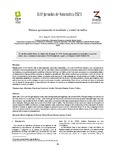Mostrar o rexistro simple do ítem
Primera aproximación al modelado y control de tráfico
| dc.contributor.author | Ortiz, Miguel | |
| dc.contributor.author | Santos, Matilde | |
| dc.contributor.author | Romana García, Manuel | |
| dc.date.accessioned | 2023-10-11T17:00:30Z | |
| dc.date.available | 2023-10-11T17:00:30Z | |
| dc.date.issued | 2023 | |
| dc.identifier.citation | Ortiz, M., Santos, M., Romana, M. 2023. Primera aproximación al modelado y control de tráfico. XLIV Jornadas de Automática, 441-446 https://doi.org/10.17979/spudc.9788497498609.441 | es_ES |
| dc.identifier.isbn | 978-84-9749-860-9 | |
| dc.identifier.uri | http://hdl.handle.net/2183/33737 | |
| dc.description.abstract | [Resumen] España posee 17.021 km de vías de alta capacidad, autovías y autopistas, y en torno al 95% del transporte por mercancías se realiza por carretera, gran parte por este tipo de vías. Estos vehículos pesados son a menudo más lentos y menos dinámicos que los turismos, y su presencia puede modificar el discurrir del flujo del tráfico, sobre todo ante escenarios con intensidades altas y en situaciones en las que dichos vehículos se desplacen lateralmente. Esto puede producir que se resienta el nivel de servicio de la vía. La motivación del presente trabajo es estudiar la formación de colas causadas por interferencias en el tráfico en vías de alta capacidad causadas por un cambio en la sección transversal de la vía y/o por vehículos pesados y lentos, para después poder aplicar acciones de control, mitigación y prevención para evitarlas o minimizarlas. Para ello, se modelará un tramo de autopista con un ramal de incorporación y una reducción del número de carriles y se estudiará comparativamente la efectividad de dos sistemas de control del tráfico. | es_ES |
| dc.description.abstract | [Abstract] Spain has 17,021 km of high-capacity roads, dual carriageways and highways, and around 95% of freight transport is carried out by road, much of it on this type of road. These heavy goods vehicles are often slower and less dynamic than passenger cars, and their presence can modify the flow of traffic, especially in scenarios with high intensity and in situations in which these vehicles move laterally. This can cause the service level of the road to suffer. The motivation of this work is to study the formation of queues caused by traffic interference on high-capacity roads, caused by a change in the cross section of the road and/or by heavy and slow vehicles, to apply control actions, mitigation, and prevention to avoid or minimize them. To do this, a highway section will be modelled with an incorporation branch and a reduction in the number of lanes and the effectiveness of two traffic control systems will be studied comparatively. | es_ES |
| dc.language.iso | spa | es_ES |
| dc.publisher | Universidade da Coruña. Servizo de Publicacións | es_ES |
| dc.relation.uri | https://doi.org/10.17979/spudc.9788497498609.441 | es_ES |
| dc.rights | Attribution-NonCommercial-ShareAlike 4.0 lnternational (CC BY-NC-SA 4.0) https://creativecommons.org/licenses/by-ncsa/4.0/ | es_ES |
| dc.rights.uri | http://creativecommons.org/licenses/by-nc-sa/3.0/es/ | * |
| dc.subject | Modelado | es_ES |
| dc.subject | Carreteras | es_ES |
| dc.subject | Cuellos de Botella | es_ES |
| dc.subject | Vehículos Pesados | es_ES |
| dc.subject | Control | es_ES |
| dc.subject | Tráfico | es_ES |
| dc.subject | Model | es_ES |
| dc.subject | Highway | es_ES |
| dc.subject | Bottleneck | es_ES |
| dc.subject | Heavy Goods Vehicles | es_ES |
| dc.subject | Queues | es_ES |
| dc.title | Primera aproximación al modelado y control de tráfico | es_ES |
| dc.type | info:eu-repo/semantics/conferenceObject | es_ES |
| dc.rights.access | info:eu-repo/semantics/openAccess | es_ES |
| UDC.startPage | 441 | es_ES |
| UDC.endPage | 446 | es_ES |
| dc.identifier.doi | https://doi.org/10.17979/spudc.9788497498609.441 | |
| UDC.conferenceTitle | XLIV Jornadas de Automática | es_ES |






